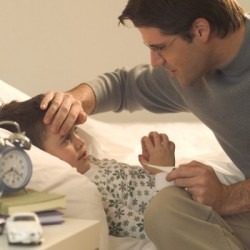 One of our families recently came to us in a feverish debate.
One of our families recently came to us in a feverish debate.
The couple’s 3-year-old son had a 102 degree fever and Mom was hesitant to treat it because she felt doing so would cover up symptoms and possibly prolong their child’s illness.
But Dad said the fever was making their son miserable and wanted to make him more comfortable with an over-the-counter fever reducer, like Motrin or Tylenol.
Both made good points – because fever is such a “hot” topic, we wanted to share some advice we gave them and countless other families who have struggled over when to treat a fever, and when to let nature take its course.
In most cases, fevers are caused by a viral or bacterial infection – such as a cold, flu, urinary tract infection, ear infection, croup or stomach virus – and will go away in a couple of days. Some children will mount a very high fever (up to 104 or above) even with a mild viral infection.
While it can be scary sometimes, it’s important to remember that a fever is a healthy sign that the body is working properly to fight or overcome infection. It has a distinct purpose – to activate the immune system and disease-fighting agents necessary to help your child recover easier and faster from an illness.
We worry most about fevers in very young children – especially infants less than 3 months old – because their immune systems are still developing. In newborns, a temperature over 100.4º F or less than 96º F can be serious and you should seek medical help right away at your doctor’s office, an urgent care clinic or the emergency room.
Fevers in children older than three months, however, are not usually a cause for concern. Guidelines by The American Academy of Pediatrics remind parents that a fever is usually just the body’s natural defense mechanism against infections and state that lowering a fever may actually prolong an illness. The AAP recommends that, in general, parents should only treat a fever if it makes their child feel uncomfortable.
We encourage fever reducing medications for children who are in significant discomfort or for those whose fevers interfere with their ability to rest, eat and stay hydrated.
We typically recommend using Ibuprofen (Motrin, Advil, etc) as opposed to acetaminophen (Tylenol) as it is more effective and since there have been recent reports with some concerning short and long term side effects with Tylenol.
That said, if a fever rises above 103.5 or lasts 7 days, you should call the doctor. Also call if your child is listless, refuses to drink fluids, if his or her condition worsens, or if the fever is accompanied by other worrisome symptoms, such as: vomiting, diarrhea, earache, severe abdominal pain, headache, stiff neck, sore throat, trouble breathing, pain when urinating, swollen joints, other localized pain and a purplish/dark rash that does not fade when you press on it.
For more helpful advice on how to take your child’s temperature and the best ways to manage fever, the American Academy of Pediatric offers a wonderful summary on how to care for your feverish child.
